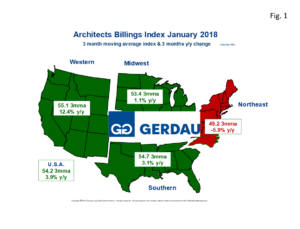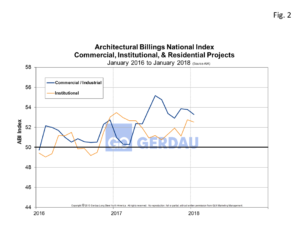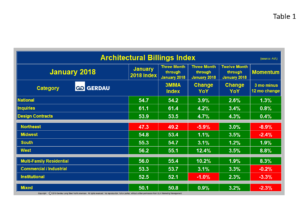Architectural Billings Index
January 2018 got off to a strong start for architecture firms as the national ABI recorded its highest score since 2007. This score of 54.7 was up from December’s 52.8 and reflects an increase in design services provided by U.S. architecture firms. It also marks four consecutive months of readings of growth in design billings. The new projects inquiry index came in at 61.1, down 0.9 of a point from last month, while the new design contracts index increased 0.5 of a point to 53.9. Regional monthly scores were: South 55.3, West 56.2, Midwest 54.8 and Northeast 47.3.
The Architecture Billings Index (ABI), is a leading economic indicator that provides an approximately nine to twelve month glimpse into the future of nonresidential construction spending activity. The results are seasonally adjusted to allow for comparison to prior months. Scores above 50 indicate an aggregate increase in billings, and scores below 50 indicating a decline.
 Figure 1 presents a map of the U.S. depicting the four ABI regions. It is color coded to show expanding billings and increased growth in green and declining billings and negative growth in red. The data is shown on this map is as three month moving averages (3MMA), and 3 month year on year (y/y), percent change. On a 3MMA basis, the national ABI score was 54.2 with a 3.9% annual growth rate. The Western region posted the highest 3MMA of 55.1 and a strong annual growth rate of 12.4%. The Southern region’s 3MMA ABI was 54.7, with an annual growth rate of 3.1%. The Midwest zone scored a 53.4, 3MMA, its annual growth rate was 1.1% y/y.
Figure 1 presents a map of the U.S. depicting the four ABI regions. It is color coded to show expanding billings and increased growth in green and declining billings and negative growth in red. The data is shown on this map is as three month moving averages (3MMA), and 3 month year on year (y/y), percent change. On a 3MMA basis, the national ABI score was 54.2 with a 3.9% annual growth rate. The Western region posted the highest 3MMA of 55.1 and a strong annual growth rate of 12.4%. The Southern region’s 3MMA ABI was 54.7, with an annual growth rate of 3.1%. The Midwest zone scored a 53.4, 3MMA, its annual growth rate was 1.1% y/y.
The Northeast was the only region in the red, recording an ABI of 49.2, 3MMA. Its annual growth rate was negative 5.9%.
Figure 2 charts the ABI sub-index for Commercial / Industrial and Institutional from 2016 to present. The Commercial/Industrial sub-index fell 0.5 point month on month to 53.3 in January, still a strong showing. The index has now been greater than 50 for 24 consecutive months. The Institutional sector scored a 52.5, off 0.2 of a point m/m, its 15th consecutive month greater than 50. The non-residential construction market has now posted twelve month-moving-total, (12MMT) growth for 72 consecutive months according to construction put in place, (CPIP) data from the U.S. Census Bureau.
charts the ABI sub-index for Commercial / Industrial and Institutional from 2016 to present. The Commercial/Industrial sub-index fell 0.5 point month on month to 53.3 in January, still a strong showing. The index has now been greater than 50 for 24 consecutive months. The Institutional sector scored a 52.5, off 0.2 of a point m/m, its 15th consecutive month greater than 50. The non-residential construction market has now posted twelve month-moving-total, (12MMT) growth for 72 consecutive months according to construction put in place, (CPIP) data from the U.S. Census Bureau.
 Table 1 lists the overall ABI and all of its sub-indexes. It presents and compares monthly and 3MMA data, showing percentage point change on both three and 12 month basis, as well as momentum. Green denotes positive change, while red indicates negative growth. National momentum, (3 month y/y subtract 12 month y/y) was positive, at +1.3%.
Table 1 lists the overall ABI and all of its sub-indexes. It presents and compares monthly and 3MMA data, showing percentage point change on both three and 12 month basis, as well as momentum. Green denotes positive change, while red indicates negative growth. National momentum, (3 month y/y subtract 12 month y/y) was positive, at +1.3%.
Inquiries momentum was higher by 0.8%. Design contract momentum gained 0.4%. Regionally, momentum was mixed with two of the four zones posted positive momentum; The Northeast recorded negative 8.9% momentum, while the Midwest recorded a negative 2.4% momentum. The South’s momentum was positive 1.9% as the West posted momentum at positive 8.8%. Momentum for the remaining project categories was mixed: Multi-family residential, (+8.3%), Commercial / Industrial, (-0.2%), Institutional, (-3.3%) and Mixed-use, (-2.3%).
In its release today, AIA Chief Economist, Kermit Baker, Hon. AIA, PhD, quoted the following:
“Healthy conditions continue across all sectors and regions except the Northeast, where firm billings softened for the second consecutive month. With strong billings and healthy growth in new projects to start the year, firms remain generally optimistic about business conditions for the next several months.”
Overall, January’s ABI report was encouraging, pointing to continued growth in construction projects for the next year.
At Gerdau we follow the ABI because it is a leading indicator of non-residential construction activity. The ABI has a proven track record and as such it is useful for business planning purposes.

